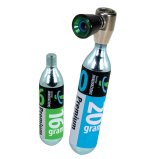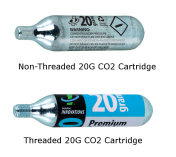If you’ve ever owned a bike, you’ve probably had more flat tires than you could count. Most bike owners will agree that, while the thrill of riding hard is worth the trouble, flat tires are still irritating to fix – time-consuming, fiddly work that takes the momentum out of your ride. What if there was a way to get back on the trail faster and easier? It turns out there is, and the answer is with CO2 inflator heads. Here’s everything you need to know about CO2 inflation:
What are the parts of a CO2 inflator?
 CO2 inflation units consist of two primary parts: The first is the inflator head or the nozzle, and the second is the cartridge itself. The CO2 cartridge contains the gas, and the inflator is the critical tool that attaches to the valve stem to inflate the tire. A cartridge can either be pressed into the inflator head, or screwed into it, depending on whether the head prefers threaded or non-threaded cartridges.
CO2 inflation units consist of two primary parts: The first is the inflator head or the nozzle, and the second is the cartridge itself. The CO2 cartridge contains the gas, and the inflator is the critical tool that attaches to the valve stem to inflate the tire. A cartridge can either be pressed into the inflator head, or screwed into it, depending on whether the head prefers threaded or non-threaded cartridges.
What are CO2 cartridges?
Basically, CO2 cartridges are little cans filled with pressurized carbon dioxide gas. Most are pretty small in size (just about the size of your thumb), making them incredibly easy to store and stash away so you always have a few cartridges handy. Though they’re small, cartridges contain CO2 gas at pressure, so that when they’re attached to the valve of your tire, they fill the tire with gas very quickly – saving you the time and physical effort associated with a manual pump.
What are threaded and non-threaded cartridges?
 Threaded cartridges have threads included in their design so they can be screwed into the inflator head. Non-threaded cartridges, on the other hand, are simply pushed or pressed into the inflator head, and pierced that way. The important point to remember is to be sure and match the cartridge style to the inflator head you’re using.
Threaded cartridges have threads included in their design so they can be screwed into the inflator head. Non-threaded cartridges, on the other hand, are simply pushed or pressed into the inflator head, and pierced that way. The important point to remember is to be sure and match the cartridge style to the inflator head you’re using.
Can you control the flow of the gas?
That depends on the kind of inflator head you have. Some units dispense air the second the CO2 canister is pierced – often resulting in lost air and frustrated riders who wasted their one shot to get it done (see video above!). More advanced CO2 inflator heads are equipped with flow control that allows you to start and stop the flow of CO2. With a better inflator head, cyclists can choose the flow technology they prefer, including twist-to-inflate, push-to-inflate or trigger controlled.
How do you know what size cartridge to get?
CO2 cartridges come in various sizes – there are 16 gram and 20 gram units, among others. Typically, smaller units are ideal for filling road tires and standard bike tires, while larger ones are often used on larger volume 29ers, mountain and fat bike tires. The best way to understand if a cartridge will work for your bike’s tires is to know the correct working pressure for your tires and then reference this handy bicycle tire CO2 inflation chart.
CO2 inflators are hugely convenient, and these are just a few of the essentials you need to cover before you start using them. Give them a try, and enjoy better, faster rides without worry!

